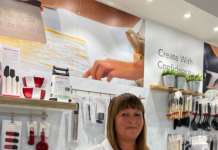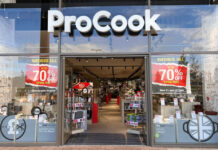Following a report from retail industry trade association Global Market Development Center, an expert examines how grocery stores can increase their share of the spend with housewares by adjusting store experiences
It’s no secret that online sales have disrupted traditional retail models, but bricks and mortar grocery stores can increase their share of the spend with housewares and by adjusting store experiences to meet changing consumer needs, according to a new report from the retail industry trade association Global Market Development Center (GMDC) that was previewed at the 2019 International Home + Housewares Show.
A preview of GMDC’s Share of the Spend Report 2019 (to be released in April) was shared by Mark Mechelse, GMDC vice president, insights & communications, and report partner Mike Anthony, CEO, engage. They were joined in a panel discussion by Sheri Best, business unit director/DMM, H-E-B; Greg Hott, director of general merchandise, Weis Markets; Peter Fahrenkopf, vice president of sales, ShurTech Brands; and Scott Bradshaw, senior vice president of sales, Bradshaw Home.
“There are two myths that we want to debunk today,†says Mark Mechelse. “Those myths are that everything must go online, and omni-channel kills all impulse purchases.â€
Traditional shoppers still exist, measuring between 40-60 per cent, depending on the survey. Even within a category that sees a lot of online shopping, only a small percentage of consumers buy that category exclusively online. What’s more, 7 in 10 shoppers who order food online from a grocery website and go inside the store to pick up their orders end up buying additional items in the centre aisles where nonfoods are merchandised.
“Most people are open to some extent to buying online or offline,†says Mike Anthony. “The battle is there to be won.â€
And while online shopping will certainly increase in coming years, online sales growth in both housewares and food & beverage is forecasted to be much slower than other categories, according to Planet Retail. For example, 1 8 per cent of housewares will be purchased online by 2023 and 13 per cent of food & beverage, compared with 91 per cent for books, music and video and 66 per cent for office and school supplies.
So why do the digitally engaged shop online? Convenience, cost, curation and experience, Mark notes. “In our research, we are tracking how and when the shopper thinks ‘I need to buy that from my phone,’ or ‘I need to make a trip to the store.’ As retailers elevate their experience and make it more immersive, stores will begin to see their loyalty increase.â€
The experience part is not a reflection of positive reactions to online shopping; it’s an issue of negative reactions to shopping in physical stores, Anthony adds.
Citing the example of Alibaba’s successful Hema grocery stores in Asia, Anthony declares: “We need to evolve the shopping experience to recognise that shoppers are shopping differently than they were before.â€
According to Mark Mechelse, GMDC’s vision of the store of the future is one that is highly engaging, communal, health focused and service oriented.
How to get there:
¬ Recognise that some categories probably aren’t winnable and focus on those that are.
¬ Re-configure stores for convenience and provide a curated selection for the local shopper.
¬ Capitalise on the mission-centric impulse and what makes sense for the shopper on this specific shopping trip (this is a great role for housewares in grocery stores).
For Sheri Best of H-E-B, “It’s all about the shopper experience. 100 per cent.†Sheri uses the example of the wide variety of can openers her store carries and how important it is for customers to be able to hold them in their hands and try them out.
For Greg Hott of Weis Markets, “It’s all about convenience. That’s the time-starved nature of our society today.â€
Recognising that many of Weis Markets’ customers are busy parents, he said his store has seen success in increasing the pet and baby categories (not just food, but wellness items and toys as well), and by making it easier for customers to grab to-go meals.
Scott Bradshaw of Bradshaw Home says he knows its products are highly impulsive buys, so Brawshaw Home has been successful working with grocery stores to capitalise on those impulses. Cross-promoting with food products and using eye-catching merchandising have paid off.
As for ShurTech Brands, Peter Fahrenkopf says its home and office products have done well in grocery stores because of the immediate solutions they offer to small projects. He also sees significant opportunity for both vendors and stores to use technology to show customers, particularly Millennials and Generation Z, how to use their products to solve their home projects.
The panelists all agreed that localisation was a key component to store success, whether curating products to appeal to shoppers at different stores, partnering with local civic groups on programs or buying from and promoting local vendors.
A video recording of the programme is available on IHA’s website, which you can see above. For more information about the International Home + Housewares Show, visit www.housewares.org
















